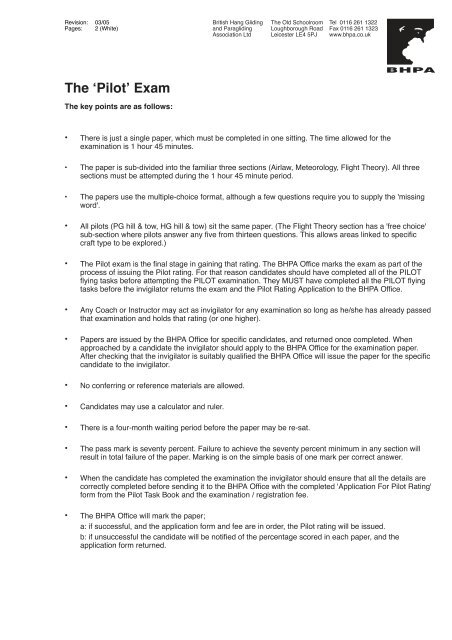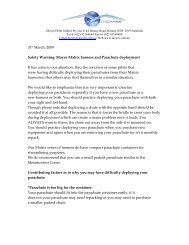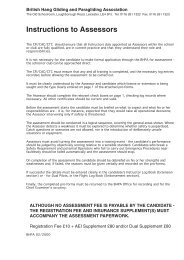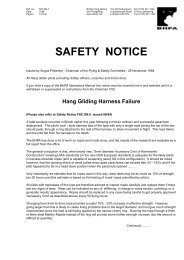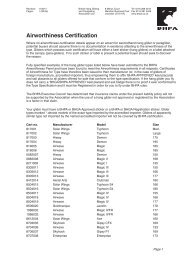Pilot Exam Syllabus - British Hang Gliding and Paragliding Association
Pilot Exam Syllabus - British Hang Gliding and Paragliding Association
Pilot Exam Syllabus - British Hang Gliding and Paragliding Association
Create successful ePaper yourself
Turn your PDF publications into a flip-book with our unique Google optimized e-Paper software.
Revision: 03/05<br />
Pages: 2 (White)<br />
<strong>British</strong> <strong>Hang</strong> <strong>Gliding</strong><br />
<strong>and</strong> <strong>Paragliding</strong><br />
<strong>Association</strong> Ltd<br />
The Old Schoolroom<br />
Loughborough Road<br />
Leicester LE4 5PJ<br />
Tel 0116 261 1322<br />
Fax 0116 261 1323<br />
www.bhpa.co.uk<br />
The ‘<strong>Pilot</strong>’ <strong>Exam</strong><br />
The key points are as follows:<br />
• There is just a single paper, which must be completed in one sitting. The time allowed for the<br />
examination is 1 hour 45 minutes.<br />
• The paper is sub-divided into the familiar three sections (Airlaw, Meteorology, Flight Theory). All three<br />
sections must be attempted during the 1 hour 45 minute period.<br />
• The papers use the multiple-choice format, although a few questions require you to supply the 'missing<br />
word'.<br />
• All pilots (PG hill & tow, HG hill & tow) sit the same paper. (The Flight Theory section has a 'free choice'<br />
sub-section where pilots answer any five from thirteen questions. This allows areas linked to specific<br />
craft type to be explored.)<br />
• The <strong>Pilot</strong> exam is the final stage in gaining that rating. The BHPA Office marks the exam as part of the<br />
process of issuing the <strong>Pilot</strong> rating. For that reason c<strong>and</strong>idates should have completed all of the PILOT<br />
flying tasks before attempting the PILOT examination. They MUST have completed all the PILOT flying<br />
tasks before the invigilator returns the exam <strong>and</strong> the <strong>Pilot</strong> Rating Application to the BHPA Office.<br />
• Any Coach or Instructor may act as invigilator for any examination so long as he/she has already passed<br />
that examination <strong>and</strong> holds that rating (or one higher).<br />
• Papers are issued by the BHPA Office for specific c<strong>and</strong>idates, <strong>and</strong> returned once completed. When<br />
approached by a c<strong>and</strong>idate the invigilator should apply to the BHPA Office for the examination paper.<br />
After checking that the invigilator is suitably qualified the BHPA Office will issue the paper for the specific<br />
c<strong>and</strong>idate to the invigilator.<br />
• No conferring or reference materials are allowed.<br />
• C<strong>and</strong>idates may use a calculator <strong>and</strong> ruler.<br />
• There is a four-month waiting period before the paper may be re-sat.<br />
• The pass mark is seventy percent. Failure to achieve the seventy percent minimum in any section will<br />
result in total failure of the paper. Marking is on the simple basis of one mark per correct answer.<br />
• When the c<strong>and</strong>idate has completed the examination the invigilator should ensure that all the details are<br />
correctly completed before sending it to the BHPA Office with the completed 'Application For <strong>Pilot</strong> Rating'<br />
form from the <strong>Pilot</strong> Task Book <strong>and</strong> the examination / registration fee.<br />
• The BHPA Office will mark the paper;<br />
a: if successful, <strong>and</strong> the application form <strong>and</strong> fee are in order, the <strong>Pilot</strong> rating will be issued.<br />
b: if unsuccessful the c<strong>and</strong>idate will be notified of the percentage scored in each paper, <strong>and</strong> the<br />
application form returned.
The <strong>Pilot</strong> <strong>Exam</strong> <strong>Syllabus</strong><br />
Any keen pilot who devotes a few evenings' study to the matter should have no problems with this exam.<br />
Most of the required information is contained in the <strong>Pilot</strong> H<strong>and</strong>book, although close study of an up-to-date<br />
aeronautical chart (especially the legend) is essential. Background reading is always advisable, <strong>and</strong><br />
attendance at club lecture evenings is strongly recommended.<br />
Once you have completed all the flying tasks for the <strong>Pilot</strong> rating, you will need to arrange a time <strong>and</strong> place to<br />
sit the exam with your club's coaching officer, a coach who has already passed the exam, or a qualified<br />
instructor. Clubs often arrange sessions where several c<strong>and</strong>idates can sit their exams at once.<br />
Air law <strong>and</strong> navigation<br />
You should:<br />
• be able to name the official documents, sources <strong>and</strong> promulgation methods of UK aviation law<br />
• underst<strong>and</strong> the law regarding Royal Flights <strong>and</strong> glider radios<br />
• be able to interpret aeronautical charts (including scales, differences in the level of information depicted,<br />
validity periods, <strong>and</strong> symbols)<br />
• underst<strong>and</strong> the basic structure of Zones, Areas <strong>and</strong> Airways<br />
• know the dimensions of ATZs <strong>and</strong> MATZs<br />
• underst<strong>and</strong> the usage of various altimeter settings (QFE, QNH, 1013.2 mb)<br />
• know the Rules of the Air (especially the low-flying rules, the right-h<strong>and</strong> traffic rule, <strong>and</strong> the aerial<br />
collision avoidance rules)<br />
• be able to define VMC <strong>and</strong> VFR (minima, rules)<br />
• know the legal definitions of night, sunset <strong>and</strong> sunrise <strong>and</strong> the relevant flying restrictions relating to them<br />
• be able to define IMC <strong>and</strong> IFR (basic differences from VMC rules)<br />
• appreciate the factors affecting compasses (deviation <strong>and</strong> variation)<br />
• be able to interpret warning signs<br />
• underst<strong>and</strong> commonly used abbreviations <strong>and</strong> initials<br />
• be able to distinguish between types of airspace that permit glider entry <strong>and</strong> those that don't (e.g. AIAAs,<br />
MATZs, Danger Areas).<br />
Meteorology<br />
You should:<br />
• underst<strong>and</strong> the relationship between wind direction <strong>and</strong> areas of high <strong>and</strong> low pressure<br />
• be able to describe in detail a cold front <strong>and</strong> a warm front (typical clouds, conditions, pressure changes,<br />
wind changes)<br />
• be able to identify some common high, medium <strong>and</strong> low cloud types, <strong>and</strong> give their approximate heights<br />
• fully underst<strong>and</strong> convection (the birth <strong>and</strong> development of a thermal, through to plotting the progress of a<br />
thermal given the ELR <strong>and</strong> initial temperature)<br />
• underst<strong>and</strong>, <strong>and</strong> be able to define <strong>and</strong> use, meteorological terms such as stability, instability, veer, back,<br />
ELR, DALR, SALR, tephigram, anabatic, katabatic<br />
• be able to describe the usual conditions associated with high- <strong>and</strong> low-pressure weather systems<br />
• underst<strong>and</strong> the causes of: valley winds throughout the day, sea breezes <strong>and</strong> sea-breeze fronts, wave lift,<br />
fog (of various types)<br />
• fully underst<strong>and</strong> <strong>and</strong> be able to interpret a synoptic chart - to the extent of being able to describe the<br />
current weather at selected locations, <strong>and</strong> to forecast likely changes<br />
• be able to link cloud types to precipitation.<br />
Flight theory <strong>and</strong> instruments<br />
You should:<br />
• be able to explain in detail how a wing creates lift, including the relevance of venturi tubes <strong>and</strong> Bernoulli's<br />
theorem<br />
• be able to define <strong>and</strong> use terms such as chord line, angle of attack, aspect ratio, centre of pressure,<br />
washout<br />
• be able to describe the aerodynamics of the stall<br />
• be able to simply describe factors affecting stability in pitch, roll <strong>and</strong> yaw<br />
• underst<strong>and</strong> the relationship between glide ratio <strong>and</strong> l/d ratio<br />
• underst<strong>and</strong> the effect of ballast<br />
• be able to name the forces on a glider in steady flight <strong>and</strong> explain their relationship<br />
• be able to name the various types of drag <strong>and</strong> explain their causes<br />
• be able to describe the relationship between the induced, parasitic <strong>and</strong> total drag <strong>and</strong> airspeed using<br />
drag curves<br />
• underst<strong>and</strong> <strong>and</strong> be able to use a polar curve<br />
• underst<strong>and</strong> the basic working principles of altimeters <strong>and</strong> variometers<br />
• underst<strong>and</strong> terms such as total energy <strong>and</strong> airmass in connection with variometers.


